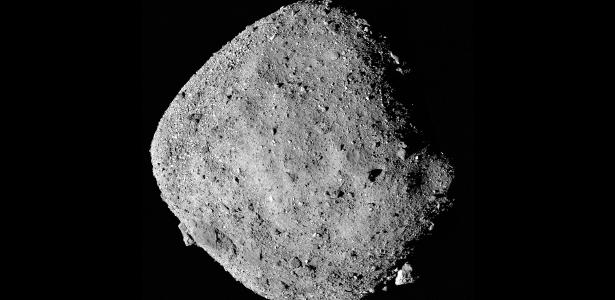Two new scientific studies have come to the conclusion that the surface of the asteroid Determine it is soft and fluffy, contrary to what the researchers imagined. The space rock is about 545 km in diameter and is known as “apocalypse asteroid” for its probability – albeit small – of colliding with Earth.
The research was published on Wednesday (7) in the journals Science e Science Advanced, and the results could have implications for a future Earth defense mission to deflect Bennu from its trajectory. The information is from the website Space.
What happened?
Scientists from the University of Arizona and the Colorado Geological Survey analyzed images of the OSIRIS-REx probewhat landed on the asteroid in October 2020 — it is already known that it is capable of hurling particles from its own surface into space.
The spacecraft was sent to collect samples of the space rock. The chosen location was an area called Nightingale, inside a crater 20 meters wide (almost a sports court). The process took just six seconds, according to NASA. released at the time.
After initial contact, it was possible to visualize the probe crushing some of the porous rocks. In the sequence, a “dust” was generated after the firing of a bottle of pressurized nitrogen against the asteroid.
In the process, the researchers observed the existence of a new hole 8 m wide on the surface, with displaced rubble and boulders scattered across the site.
“We expected the surface to be quite rigid, as if you were touching a pile of gravel: some dust flying and some particles jumping,” Dante Lauretta, principal investigator for OSIRIS-REx and a planetary scientist at the University of Arizona, told Space. . “We were surprised. We saw a giant wall of debris flying away from the side of the sample.”
Lauretta added that the plan was to collect a larger volume of the sample from Bennu (they got 250 grams), but the probe sank 70 cm, which showed the surface had “no resistance whatsoever”. It was soft “and oozed like a fluid.”
Calculations on the asteroid’s density were then performed. According to the researcher, around 500 to 700 kg per cubic meter. For comparison, a terrestrial rock has a density about six times greater, something around 3,000 kg per cubic meter, compares Space.
According to Lauretta, the underground part of the asteroid looked redder compared to its bluish surface. This indicates that cosmic rays and space weather erode exposed rocks.
the second study
The second survey looked at forces exerted on OSIRIS-REx during impact as it touched the asteroid’s surface. The results confirmed the record of the previous study.
“As rochas [da superfície] are very porous and there’s a lot of empty space between them,” said Kevin Walsh, a geologist at the Colorado Geological Survey.
“[O afundamento da sonda] provided the first experience of actually pressing something to the surface. If we were ever going to try to deflect something like that, we would need to know what the surface is like so it doesn’t just absorb the impact,” he added.
the asteroid of the apocalypse
The chance of asteroid Bennu colliding with Earth is one in 2,700 during the years 2175 and 2199, according to NASA. Even so, the space rock is considered the most dangerous ever known.
Scientists have been poring over for some time to understand its mysteries. A possible collision would result in Earth-wide disturbances.
Bennu was chosen for the study because of its similarities to other potentially dangerous asteroids and comets, called “Near-Earth Objects” (NEOs), or near-Earth objects.
With the study of the sample of the asteroid, it is possible to find out more about it, in addition to having more data on the formation of planets and the emergence of life.
facts about Bennu
- It is like a “pile of rubble”: rocks grouped together and held together by the force of gravity.
- Your rotation lasts two hours, which is considered low. Thus, the rocks around them come into contact with high temperatures in a short time. Stresses and fractures in rocks, which are thrown, can occur.
- In 2021, scientists observed that it was forming a meteor shower. Until then, it was believed that this type of phenomenon only involved debris left by comets when they came close to the Sun, and not by grains on its surface.
*With text by Marcella Duarte.
–


